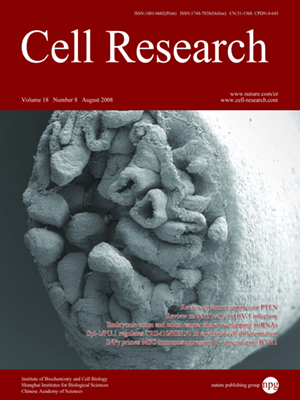
Volume 18, No 8, Aug 2008
ISSN: 1001-0602
EISSN: 1748-7838 2018
impact factor 17.848*
(Clarivate Analytics, 2019)
Volume 18 Issue 8, August 2008: 879-888
ORIGINAL ARTICLES
Induction of apoptosis by shikonin through a ROS/JNK-mediated process in Bcr/Abl-positive chronic myelogenous leukemia (CML) cells
Xin Mao*, Chun Rong Yu*, Wen Hua Li and Wen Xin Li
State Key Laboratory of Virology, College of Life Sciences, Wuhan University, Wuhan 430072, China
Correspondence: Wen Xin Li(liwxlab@whu.edu.cn)
This study examined the signaling events induced by shikonin that lead to the induction of apoptosis in Bcr/Abl-positive chronic myelogenous leukemia (CML) cells (e.g., K562, LAMA84). Treatment of K562 cells with shikonin (e.g., 0.5 μM) resulted in profound induction of apoptosis accompanied by rapid generation of reactive oxygen species (ROS), striking activation of c-Jun-N-terminal kinase (JNK) and p38, marked release of the mitochondrial proteins cytochrome c and Smac/DIABLO, activation of caspase-9 and -3, and cleavage of PARP. Scavenging of ROS completely blocked all of the above-mentioned events (i.e., JNK and p38 phosphorylation, cytochrome c and Smac/DIABLO release, caspase and PARP cleavage, as well as the induction of apoptosis) following shikonin treatment. Inhibition of JNK and knock-down of JNK1 significantly attenuated cytochrome c release, caspase cleavage and apoptosis, but did not affect shikonin-mediated ROS production. Additionally, inhibition of caspase activation completely blocked shikonin-induced apoptosis, but did not appreciably modify shikonin-mediated cytochrome c release or ROS generation. Altogether, these findings demonstrate that shikonin-induced oxidative injury operates at a proximal point in apoptotic signaling cascades, and subsequently activates the stress-related JNK pathway, triggers mitochondrial dysfunction, cytochrome c release, and caspase activation, and leads to apoptosis. Our data also suggest that shikonin may be a promising agent for the treatment of CML, as a generator of ROS.
Cell Research (2008) 18:879-888. doi: 10.1038/cr.2008.86; published online 29 July 2008
FULL TEXT | PDF
Browse 2029


